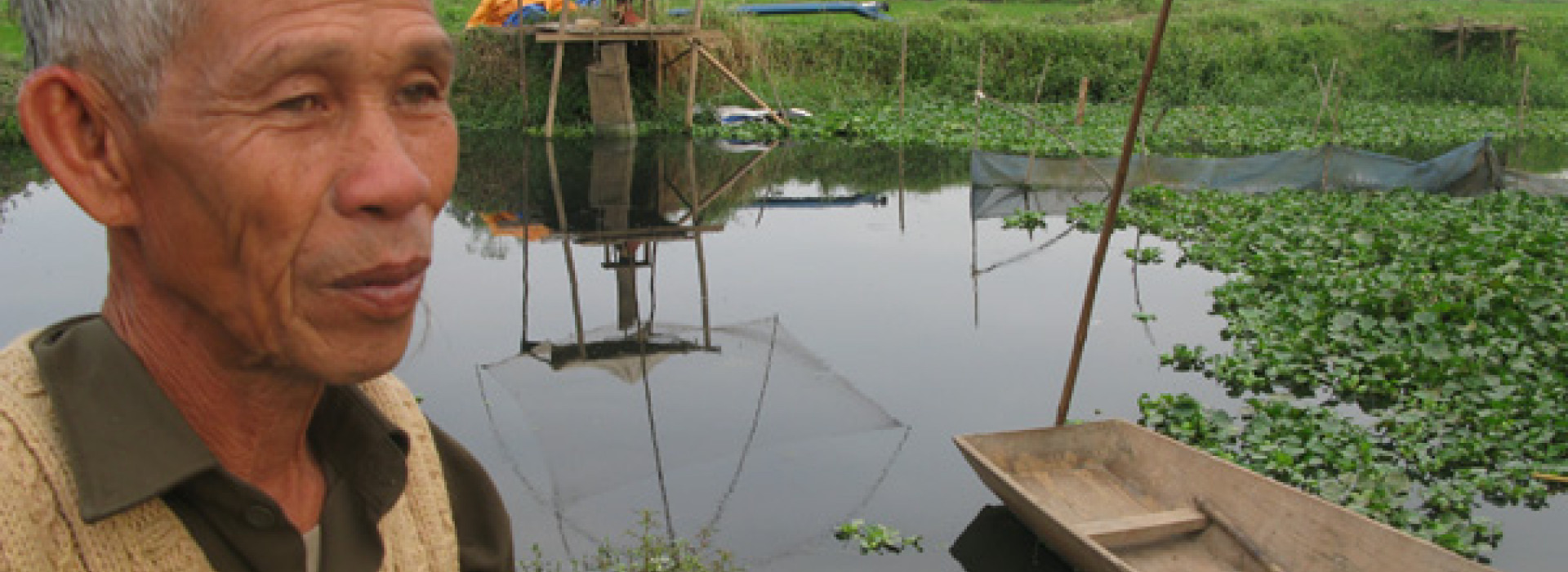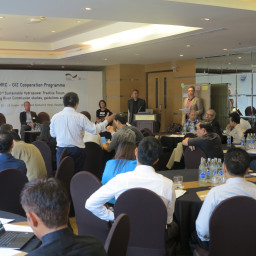A life less ordinary
If he worked in a corporate world, Sai-ngern Inthawong, 63, could have described himself as a ‘self-starter’ for what he has accomplished in a wetland located on the eastern edge of Vientiane Capital.

Sai-ngern Inthawong relies very much on the Bueng That Luang wetland as his source of food and income.
From time to time, extreme weather conditions such as intensified floods, affected the wetland, where he has lived and worked for years. Such events were unexpected for him, he said, but he managed to survive through the difficulties despite being unprepared.
“Whenever there was a big flood, I moved my poultry to a higher feeding ground and herded my cattle away to my friend’s farm,” he said.
These are simple methods he has innovated to deal with unusually intense floods that have hit the wetland here, Bueng That Luang. The marsh has been a lifeline for him and his family— as a source of fish, snails and vegetables that his family relies on for their main income. During the dry season, his family cultivates rice in a plot of land that is usually swamped during the rainy season.
“If numbers of fish are decreased or there are much less for me to catch it could be hard for us to survive,” said Mr Sai-ngern who sells fish, snails and vegetables he gathers from the pond at a market located in the suburb of Vientiane.
This wetland is a network of canals and ponds that remain fertile, even in the dry season. It absorbs water flowing from the Mekong River as well as waste water from the city’s municipality. It has played a key role in purifying water pollution and naturally controlling flood—something considered a boon for the city’s dwellers.
Bueng That Luang is also a rich source of biodiversity. However, like many other wetlands in the Mekong region, it is likely to be affected by predicted changes of climate conditions.
With a projected increase in rainfall and temperature throughout the Mekong River Basin, this and other wetlands are among those anticipated to bear the brunt of impacts of climate change.
“There could be more intense rainfall in the wet season, which could also last for a shorter period,” said Peter-John Meynell, a wetlands expert who has worked in the region for a decade. He was sharing his perspectives on worst-case scenarios of climate change impacts in the Mekong Basin.
Less rain and longer dry seasons can also be expected, he said
Changes, such as these, in weather patterns means the biodiversity of wetlands in the basin are likely to be at risk. Different types of wetland habitats—vegetation, fish, insects and amphibians, could be affected, said Mr Meynell.
This trend could be translated into changes in the livelihoods of people living in different marshes in the basin, he said. At Bueng That Luang alone, thousands of people depend on the 20 km2 marsh as a primary source for their food and income.

A man fishes in Bueng That Luang, a marsh on the eastern edge of Vientiane.
The Mekong River Commission, an inter-governmental body that works with regional stakeholders on the issue, has recently commissioned the International Centre for Environment Management (ICEM) in collaboration with IUCN, WorldFish Centre and the Southeast Asia START, a regional research centre, to conduct an assessment study on the impacts and vulnerability of wetlands to climate change in the Lower Mekong Basin.
“The project will consider how changes to weather patterns will affect the different types of wetland habitats found in the basin,” said Hanne Bach, MRC’s Environment Programme’s Chief Technical Advisor.
Since the marshes have experienced extreme floods and drought, the study will also take a closer look at how local people and the biodiversity in these areas have adapted to such changes, like the basic adaptation methods Mr Sai-gnern initiated.
“We will come up with case studies which will capture local models of adaptation for wider use within the region,” said Ms Bach.
Then, the study plans to lead to recommendations for changes in existing policies and practices in the basin, she added.
For Mr Sai-gnern, he said he has no worries about his future as long as he can make a living out of the marsh.




